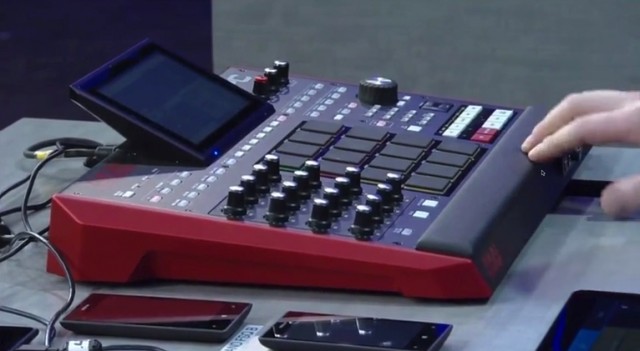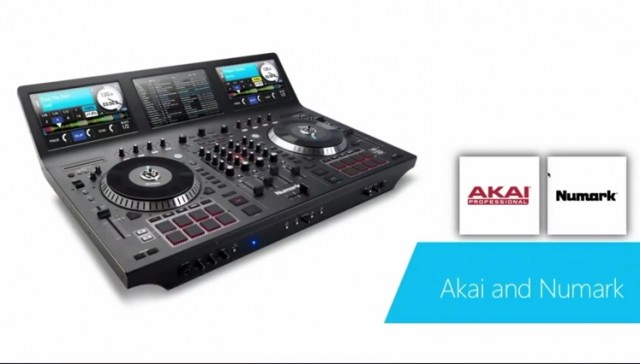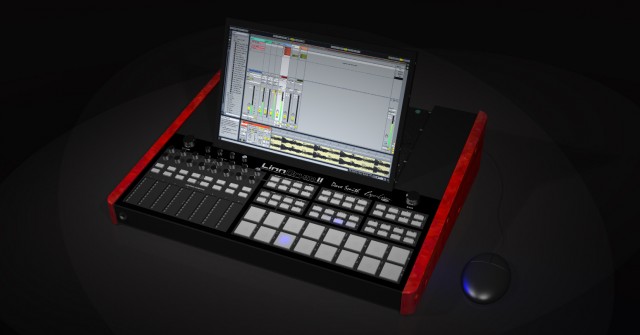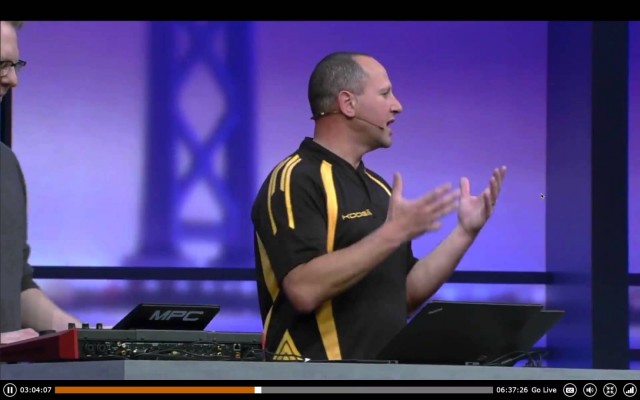The dedicated drum machine is at a crossroads. Computer hybrids are simply capable of more than dedicated hardware – and that, in turn, has changed user expectations. You can go retro, as analog machines have done. You can go small, as boxes like the volca beats and upcoming Akai Rhythm Wolf do. You can stay the course, as Elektron does with their boxes. You can go hybrid, as Native Instruments’ Maschine, Arturia’s Spark, and Akai’s Renaissance and MPC Fly do.
Or, there’s one other option. You could put the soul of a computer – and the touchscreen interface – in that dedicated box.
A surprise revelation of the Microsoft Build developer conference was that Akai appears to be going that way with their flagship product. The MPC was onstage, sporting a traditional MPC form factor but with a UI augmented by touch. And De:bug Magazine (German) reports on a leak on the MPC Forum with details from a developer that suggest that the next MPC will have Intel – and Windows – inside.
KOMMT DIE NÄCHSTE MPC MIT WINDOWS EMBEDDED?
This could be a big loss for Apple, too, in this sector. Sources tell me that Apple is getting more restrictive about hardware accessories they’ll let run on their devices. I can’t confirm specifics, but it seems logical to me that some vendors would gravitate toward an OS developer that offers an embedded platform they can build on – and iOS, in many ways, isn’t it, not once you graduate from simple apps.
In the video from Build, you might assume that this is just a Windows tablet augmenting more conventional music hardware. But the developer suggests there’s more to it than that:
The prototype was running an Intel Next Unit of Computing (NUC) with a core i5. It did not require any external PC. TBD what the final device runs, nut I’d expect something similar. Performance was excellent because the device is optimized to so one thing, not to also serve as email device, etc. You can even hook a keyboard, mouse, and external display to the MPC if you want. That said, I was able to do all the sample loading just using the touch screen and a thumb drive.
Other companies: I’m not going to name names, but we’re working with several tiers from most of the big names that produce software and hardware down to a selection of some of the smaller companies that create unique or impactful software. I’ve been in the room or on the phone with each of these. InMusic (Akai/Numark) was included when one of our field folks pointed out to me that they were doing cool things with embedded and their next gen of products.
It’s a hood enough sample to make sure we have feedback covering the spectrum of requirements for creative/pro audio.
A slide also shows a Numark DJ device, integrating a control surface and displays. It looks as big as a truck – but it also looks like hefty competition for Pioneer’s CDJ.
Now, this is Windows Embedded, not Windows. That means you couldn’t, say, run Ableton Live on the same box – but, on the other hand, there’s no OS to maintain, and functionally the experience should be the same as running dedicated hardware (see the performance comment above).
But what it could resolve is satisfying growing needs from users who want more functionality, better displays, and better interaction, accustomed as they are now to desktop computers, iPads, and the like.
In fact, this same path was suggested by none other than original MPC designer Roger Linn. In a series of designs, he tried to find ways of combining PC and drum machine, as in the image here. Some used a controller (a “Surface,” ironically sharing a name with Microsoft’s product), but some proposed an embedded machine running an OS like Linux. In fact, he told me specifically that part of his thinking was to answer this greater sense of user demands for features.
In the end, that design was shelved, and I look forward to seeing Roger demo his upcoming Linnstrument 3D surface. The Roger Linn – Dave Smith collaboration turned into Tempest, a more conventional drum machine with an analog architecture (and no sampling, even), and the rest is history. But InMusic (Akai) seem to be betting on every possible alternative, from small analog hardware to iPad products to, now, this.
And this could at last answer a burning question. Many MPC die-hards have felt abandoned by the company, absent a flagship, all-in-one production machine. Some do turn to products like Maschine or Renaissance. But others may want the experience of making music without the distractions, performance issues, and added maintenance of a desktop computer. (I love my desktop, but … well, I do also hate it, so I feel their pain, and can’t really argue with them.) If the software is good, this new MPC could offer the best of both worlds. Time will tell.
And there’s a similar possibility in the DJ market, too.



